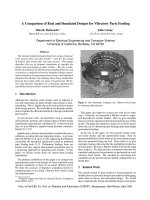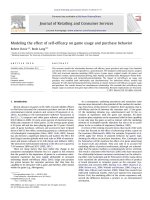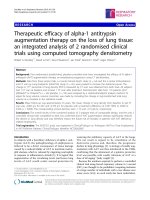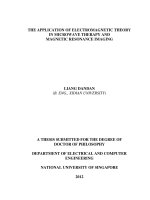Comparison of the therapeutic efficacy of microwave ablation and radio-frequency ablation for hepatoccelular carcinomas
Bạn đang xem bản rút gọn của tài liệu. Xem và tải ngay bản đầy đủ của tài liệu tại đây (514.55 KB, 8 trang )
Journal of military pharmaco-medicine no2-2018
COMPARISON OF THE THERAPEUTIC EFFICACY OF
MICROWAVE ABLATION AND RADIO-FREQUENCY ABLATION
FOR HEPATOCCELULAR CARCINOMAS
Vo Hoi Trung Truc*; Tran Viet Tu**
SUMMARY
Objectives: Comparison of the therapeutic efficacy of percutaneous microwave ablation (MWA)
and radio frequency ablation (RFA) for treatment of hepatocellular carcinomas (HCC). Subjects
and method: 136 patients with HCC were divided into two groups. 66 patients with 71 tumors
were treated with MWA and 70 with 74 tumors were treated with RFA. Results: The complete
response rate of MWA and RFA were 95.7% and 97.3%, respectively. No significant differences
in the complete response rate between modalities (MWA and RFA) and tumor sizes (< 3 cm
and ≥ 3 cm). The disease-free survival (DFS) rates at 1 and 2 years in the MWA group were
68.2% and 43.9% with a mean DFS period of 17.4 ± 9.2 months. Those at 1 and 2 years in the
RFA group were 65.7% and 41.4%, respectively with a mean DFS period of 16.8 ± 8.7 months.
No significant difference in the DFS rates (p = 0.76 and 0.767) and DFS period (p = 0.446)
between 2 groups. Platelet, age and AFP were identified independent prognostic factors for
DFS by using Cox’s proportional hazards model. Conclusion: MWA has the similar efficacy to
RFA in treating HCCs. Platelet, age and AFP were prognostic factors for DFS.
* Keywords: Hepatocellular carcinoma; Microwave ablation; Radio frequency ablation.
INTRODUCTION
Liver cancer in men is the fifth most
frequently diagnosed cancer worldwide
but the second most frequent cause of
cancer death. In women, it is the seventh
most commonly cancer and the sixth
leading cause of cancer death [3]. Local
ablation therapies have been recognized
as radical, minimally invasive ones for
early HCCs. Among a variety of these,
RFA is the most common thermal ablation
modality worldwide. MWA was first
deployed in Choray Hospital in June 2012
and should be proven its efficacy in
destroying liver tumors in Vietnam.
Therefore, we did this research in order
to: Compare the local ablation effects of
percutaneous MWA and RFA in the
treatment of HCC
SUBJECTS AND METHODS
1. Subjects.
136 patients were diagnosed with
HCCs and treated in the Liver Tumor
Department, Choray Hospital between
June, 2012 and December, 2013. They
were divided into two groups: MWA group
(66 patients with 71 tumors) and RFA
group (70 patients with 74 tumors).
* Choray Hospital
** 103 Military Hospital
Corresponding author: Vo Hoi Trung Truc ()
Date received: 20/11/2017
Date accepted: 22/01/2018
134
Journal of military pharmaco-medicine no2-2018
* Inclusion criteria: The pathological
enhancement within the ablation area or
finding is HCC, liver tumors (one or two
the target tumor [1]. All patients with
nodules of 5 cm or smaller in size), Child-
incomplete ablation were further treated
Pugh A or B, prothrombin time more than
by complementary ablations. All patients
50%
were regularly followed up every 2 - 3
and
platelet
count
more
than
3
50.000/mm , unresectable HCC or patients’
refusal to undergo surgery, patients agree
to participate in the study.
months during the follow-up.
Continuous variables were reported as
mean ± standard deviation. Differences in
* Exclusion criteria: Patients with PST
categorical
variables
and
continuous
> 2, venous thrombosis (portal vein, hepatic
variables
vein, lower vena cava), bile duct dilation,
analyzed with the Chi-square test or
distant metastasis or invasion of adjacent
Fisher’s exact test and with student’s
organs.
t-test,
between
respectively,
groups
using
Stata
version
A total of 136 eligible patients were
signed-rank test is used when comparing
enrolled in this prospective cohort study.
two matched samples. DFS curve was
Under the guidance of real-time ultrasound,
evaluated using Kaplan-Meier curve and
the antenna of the microwave system
compared using the log-rank test. To
AveCure (Medwaves, USA) or the electrode
identify the prognostic factors for DFS, 12
of Valley-lab Cool-tip™ RF Ablation System
variables were used, including ablation
(Covidien, USA) was percutaneously probed
modality (MWA/RFA), age (< 60, ≥ 60),
into the tumors. A RFA was applied for 5 -
sex (male, female), albumin (< 3.5; ≥ 3.5
12 mins and a MWA for 7.5 - 10 mins until
mg%), bilirubine (< 2, ≥ 2 mg%), platelet
whole tumor was ablated completely with
(< 100, ≥ 100), prothrombin time (< 16,
a safety margin of 5 - 10 mm. Patients
≥ 16), AFP level (< 200, ≥ 200), tumor
were discharged one day after procedures.
differentiation (1, 2, 3), tumor size (< 3,
A
was
≥ 3 cm), tumor number (1, 2), BCLC (0, A,
performed 1 month after ablation. The
B). Variables with p values less than 0.05
local efficacy was evaluated. Complete
in the univariate analysis were entered
ablation was defined as that the ablated
into a Cox proportional hazards model for
area completely covers the target tumor.
multivariate analysis. A p-value less than
Incomplete ablation was defined as any
0.05 was considered statistically significant.
CT-scan
software.
the
were
2. Methods.
contrast-enhanced
13.0
the
The Wilcoxon
135
Journal of military pharmaco-medicine no2-2018
RESULTS
1. Patients’ baseline characteristics.
Table 1: Characteristics of patients.
MWA group (n1 = 66) RFA group (n1 = 70)
p
Sex
Male/female
55/11
62/8
0.379
Age
Mean ± SD
60.8 ± 10.9
62.1 ± 10.7
0.408
Platelet (G/L)
Mean ± SD
154.3 ± 68.5
172.2 ± 68.1
0.129
Fibrinogen (g/L)
Mean ± SD
2.8 ± 1.3
2.8 ± 0.7
0.958
Prothrombin time (sec)
Mean ± SD
13.8 ± 2.2
14.2 ± 1.8
0.312
APTT (sec)
Mean ± SD
31.5 ± 4.3
31.9 ± 5.1
0.615
AST(U/L)
Median (IQR)
61 (46 - 94)
60(45 - 87)
0.459
ALT(U/L)
Median (IQR)
48 (37 - 88)
45(28 - 70)
0.729
Bilirubine (mg/dL)
Median (IQR)
0.9 (0.6 - 1.2)
0.8(0.6 - 1.1)
0.221
Albumin blood (g/dL)
Mean ± SD
4.2 ± 0.6
4.2 ± 0.5
0.629
Tumor differentiation
1/2/3
21/44/1
20/49/1
0.854
A/B
60/6
63/7
1.00
0/A/B
3/59/4
5/63/2
0.579
PST
0/1
62/4
66/4
1.00
The number of nodules
1/2
61/5
66/4
0.739
Median follow-up time
Median (IQR)
24.7 (14 - 25.7)
24.4 (15.7 - 25.4)
0.806
Child-Pugh
BCLC
(n1: Total number of patients)
There was no significant difference in clinical backgrounds between the two groups.
2. Ablation effectiveness.
Table 2: AFP changing after treatments.
AFP level
MWA group (n1 = 66)
RFA group (n1 = 70)
Before the procedure
Median (IQR)
11.8 (6.0 - 39.7)
11.2 (5.8 - 28.9)
After the procedure
Median (IQR)
7.5 (4.6 - 19.4)
8,1 (3.6 - 13.3)
< 0.001
< 0.001
p
AFP levels after treatment decreased significantly in both two groups.
136
Journal of military pharmaco-medicine no2-2018
Table 3: Technique effectiveness.
MWA group (n2 = 71)
p
RFA group (n2 = 74)
< 2/2 - 3/>3
3/27/41
0.534
5/33/36
Mean ± SD
3.3 ± 1
0.573
3.2 ± 1
1/≥ 2
57/14
0.504
56/18
Mean ± SD
1.2 ± 0,4
0.220
1.3 ± 0.6
Nodule size (cm)
Sessions for one
nodule
Complete response
Overall
95.8%
97.3%
Nodule ≤ 3 cm
97%
97.5%
Nodule > 3 cm
94.6%
97.1%
(n2: Total number of nodules)
No significant differences in nodule sizes and the number of ablation sessions for
the target nodule were observed between the MWA and the RFA groups.
The CA rate in the tumor treated with MWA was the same as one in the tumors
treated with RFA.
3. Disease free survival.
Table 4: DFS and rate.
MWA group (n1 = 66)
RFA group (n1 = 70)
p
Disease free 1-year survival
68.2%
65.7%
0.76
Disease free 2-year survival
43.9%
41.4%
0.767
17.4 ± 9.2 (months)
16,8 ± 8.7 (months)
0.724
Mean DFS
No significant differences in the DFS rates and DFS period between two groups.
4. Prognostic factors.
Table 5: Prognostic factors of complete response.
Multiple linear regression
Odds ratio
p-value
95%CI
Ablation modality (MWA/RFA)
1.5
0.64
0.2
9.6
Nodule size (≤ 3 cm, > 3 cm)
0.6
0.64
0.1
4
No significant differences in the complete response rate between modalities (MWA
and RFA) and tumor sizes (< 3 cm and ≥ 3 cm).
137
Journal of military pharmaco-medicine no2-2018
Table 6: Prognostic factors of DFS.
Multivariate analysis
Hazard ratio
p-value
95%CI
Age(< 60, ≥ 60)
0,6
0.021
0,4
0,9
Platelet (< 100, ≥ 100)
0.4
0.002
0.2
0.7
AFP level (< 200, ≥ 200)
1.5
0.013
1.1
1.9
Variables were analyzed: ablation modality (MWA/RFA), sex (male, female), age
(< 60, ≥ 60), albumin (≤ 3.5; > 3.5 mg%), bilirubine (≤ 2, > 2 cm), platelet (< 100,
≥ 100), prothrombin time (< 16, ≥ 16), AFP level (< 200, ≥ 200), tumor differentiation
(1, 2, 3), nodule size (< 3, ≥ 3 cm), nodule number (1, 2), BCLC (0, A, B)
Age, platelet count and AFP were independent prognostic factors of DFS.
DISCUSSION
There was no significant difference in
clinical backgrounds between the two
groups. AFP levels after treatment decreased
significantly in both two groups.
1. Technique effectiveness of MWA.
Complete response confirmed at 1 month
after treatment is very important. It is one
of the main criteria to evaluate the efficacy
of ablation. The complete response rate
of MWA group was 95.8%. This rate is not
different from many other studies. Liu et al
realized that 85.7% of tumors in the
915 MHz MW group and 73.7% of tumors
in the 2,450 MHz MW group achieved
complete ablation [4]. Xu et al found that
the complete response was 94.6%.
In our study, there was no difference
between the complete response rate in
nodules ≤ 3 cm and the one in nodules
> 3 cm (p = 0.64) [7]. Hetta et al showed
that MW ablation success was higher with
nodules ≤ 3 cm (98.3%) in comparison to
nodules > 3 cm (92.5%). However, the
138
difference was not significant (p = 0.301)
[2]. Lu et al documented the complete
response rate achieved using MWA group
was 94.9%. Complete response rates were
98.6% in tumors ≤ 3 cm versus 83.3% in
tumors > 3 cm (p = 0.01) [8]. Wang et al
found that patients with tumor > 5 cm
were less likely to gain complete ablation
at first microwave ablation and more
likely to suffer from incomplete ablation
after two sessions of MWA compared with
those with tumor ≤ 5 cm. However, tumor
number and location have no significant
impact on technique effectiveness [6].
2. The therapeutic efficacy of MWA
versus RFA.
Theoretically, MWA outperforms RFA
in some areas, such as faster ablation
time, bigger coagulation volume, higher
tumor temperature and being less affected
by the heat-sink effect of local blood vessels.
However, we found that the CR rates using
MWA and RFA were 95.8% and 97.3%,
respectively. There was no difference
Journal of military pharmaco-medicine no2-2018
between the two groups (p = 0.64). Lu et
al found that the complete response rates
were 94.9% using MWA versus 93.1%
using RFA (p = 0.75) [8]. Zhang et al
reported the complete response rate was
achieved in 86.7% of tumors treated with
MWA and 83.4% of the treated those with
RFA, with no significant difference between
the two groups (p = 0.957) [9]. Xu et al
found that the complete response rate in
MW and RF ablation was 94.6% and
89.7%, respectively (p > 0.05) [7].
3. Disease free survival.
According to our study, the 1-year and
2-year DFS rates in the MWA group were
68.2% and 43.9%, respectively with a
mean DFS period of 17.4 ± 9.2 months.
The 1-year and 2-year DFS rates in the
RFA group were 65.7% and 41.4% with a
mean DFS period of 16.8 ± 8.7 months.
There was no difference in disease free 1year survival (0.76), disease free 2-year
survival (p = 0.767) and mean DFS period
(p = 0.724) between the two groups. The
outcome in our study is better than that in
the Lu et al’s study. Lu et al showed that
the DFS rates at 1, 2, 3 years in the
MWA group were 45.9%, 26.9%, 26.9%,
respectively, with a mean DFS period of
15.5 months. The DFS rates at 1, 2, 3
years in the RFA group were 37.2%,
20.7%, 15.5%, respectively, with a mean
DFS period of 16.5 months (p = 0.53) in
comparison with the MWA group [8].
Zhang et al showed that the 1-, 3-, 5-year
DFS rates were 62.3%, 33.8%, 20.8%,
respectively, for the MWA group and
70.5%, 42.3%, 34.2%, respectively for the
RF ablation group. There was no significant
difference between these two groups
(p = 0.123) [9]. Vogl et al reported that the
progression-free survival rate at 1 and
2 years were much higher than ours. In
the Vogl et al’s study, the progressionfree survival rate for patients treated with
MWA of 1, 2, 3 years were 97.2%, 94.5%,
91.7 and treated with RFA were 96.9%,
93.8%, and 90.6%, respectively (p = 0.98)
[5]. The difference was not significant
between the two groups (p = 0.98) [5]. We
confirmed that the prognostic factors of
DFS were age (< 60, ≥ 60), platelet
(< 100, ≥ 100) and AFP level (< 200,
≥ 200). Wang et al identified levels of AFP
and GGT as independent prognostic
factors of recurrence-free survival in
patients receiving MWA [6].
139
Journal of military pharmaco-medicine no2-2018
CONCLUSION
Findings in this study revealed that the
complete response rates of MWA and
RFA were 95.8% and 97.9%, respectively.
There was no difference between the two
groups (p = 0.64). There was no difference
between the complete response rate in
nodules ≤ 3 cm and the one in nodules
> 3 cm (p = 0.64). The 1-year and 2-year
DFS rates in the MWA group were 68.2%
and 43.9% with a mean DFS period of
17.4 ± 9.2 months. The 1-year and 2-year
DFS rates in the RFA group were 65.7%
and 41.4% with a mean DFS period of
16.8 ± 8.7 months. There was no difference
in disease free 1-year survival (0.76),
disease free 2-year survival (p = 0.767).
We confirmed that age (< 60, ≥ 60),
platelet (< 100, ≥ 100) and AFP level
(< 200, ≥ 200) were the prognostic factors
of DFS after ablations.
REFERANCES
1. Goldberg S.N, Charboneau J.W, D.G. r,
Dupuy D.E, Gervais D.A, Gillams A.R, Kane
140
R.A, Lee F.T Jr, Livraghi T, McGahan J.P,
Rhim H, Silverman S.G. Image-guided tumor
ablation: Proposal for atandardization of terms
and reporting criteria. Radiology. 2003, 228
(2), pp.335-345.
2. Hetta O.M, Shebrya N.H, Amin S.K.
Ultrasound-guided microwave ablation of
hepatocellular carcinoma: Initial institutional
experience. The Egyptian Journal of Radiology
and Nuclear Medicine. 2011, 42 (3-4), pp.
343-349.
3. Jemal A, Bray F., Center M.M et al.
Global cancer statistics. CA: a Cancer Journal
for Clinicians. 2011, 61 (2), pp.69-90.
4. Liu F.Y, Yu X.L, Liang P et al.
Comparison of percutaneous 915 MHz
microwave
ablation
and
2,450
MHz
microwave ablation in large hepatocellular
carcinoma. J Hyperthermia. 2010, 26 (5),
pp.448-455.
5. Vogl T.J, Farshid P, Naguib N.N et al.
Ablation therapy of hepatocellular carcinoma:
a comparative study between radiofrequency
and microwave ablation. Abdom Imaging.
2015, 40 (6), pp.1829-1837.
Journal of military pharmaco-medicine no2-2018
6. Wang T, Lu X.J, Chi J.C et al. Microwave
ablation of hepatocellular carcinoma as firstline treatment: long term outcomes and prognostic
factors in 221 patients. Scientific Reports.
2016, 6, p.32728.
8. Lu M.D, Xu H.X, Xie X.Y et al.
Percutaneous microwave and radiofrequency
ablation for hepatocellular carcinoma: a
retrospective comparative study. J Gastroenterol.
2005, 40 (11), pp.1054-1060.
7. Xu H.X, Xie X.Y, Lu M.D et al.
Ultrasound-guided
percutaneous
thermal
ablation of hepatocellular carcinoma using
microwave and radiofrequency ablation.
Clinical Radiology. 2003, 59 (1), pp.53-61.
9. Zhang L, Wang N, Shen Q et al.
Therapeutic
efficacy
of
percutaneous
radiofrequency ablation versus microwave
ablation for hepatocellular carcinoma. PLoS
One. 2013, 8 (10), p.e76119.
141









